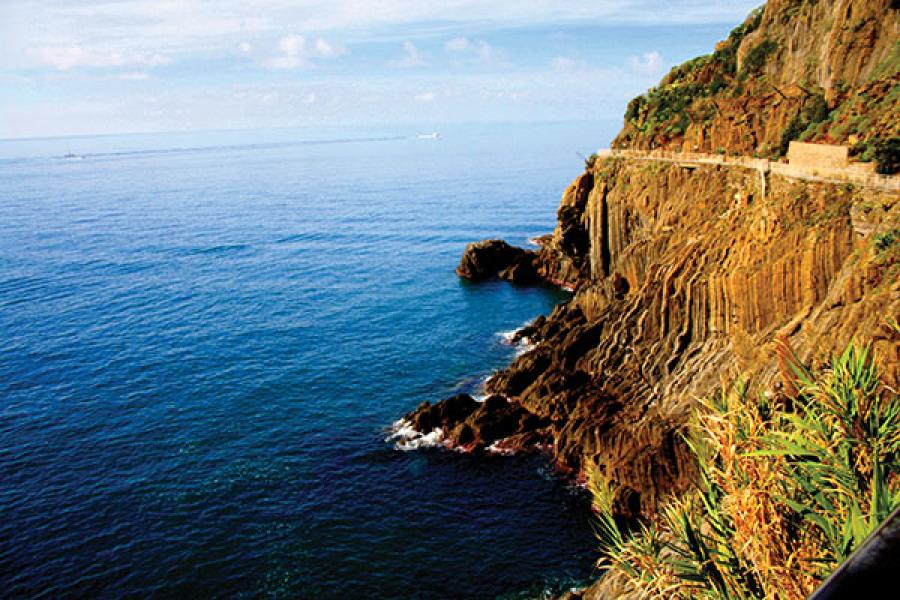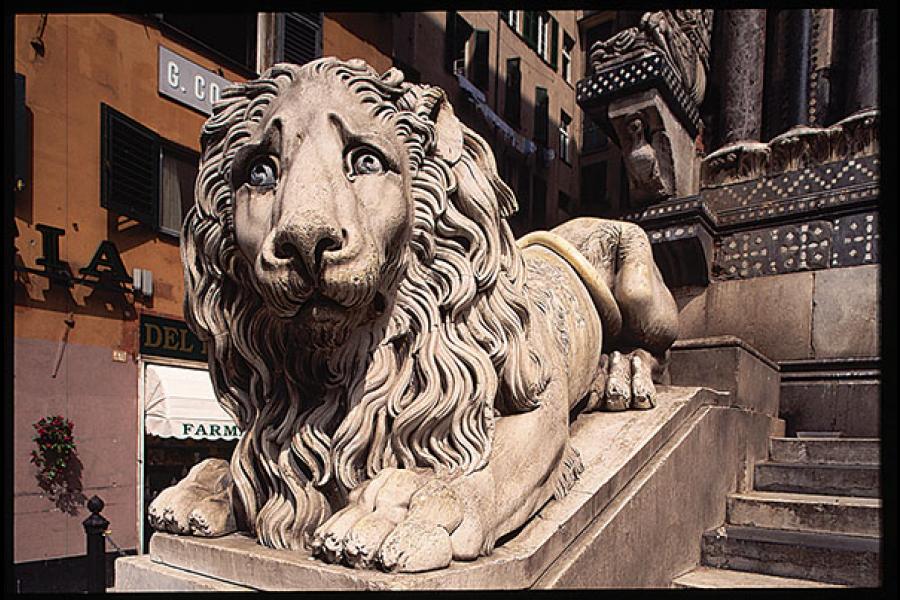
La Dolce Vita In Genoa: A couple's trail in picturesque Italy
S&V enjoy the kind of travel that entails late nights followed by no wake-up calls, plenty of exploration on foot, an abundance of good food and even better alcohol
I arrive from New York a couple of hours before S. She is flying to Milan from Delhi. If entry to the G7 Group of Nations is based on first impressions created by gateway airports, Italy would barely qualify, even for the G50. Milan’s Malpensa Airport is not decrepit, it just hasn’t aged as well as other Italian icons (Sophia Loren jumps memorably to mind).
The cab ride to town from Malpensa is 90 euros flat, which will get you to Manhattan from JFK Airport with enough left over for a tip so generous that your cabbie’s next born would bear your name. We take the train which, at 12 euros per person, is a steal and will convey you to the relatively central Milan Cadorna railway station in about 30 minutes. (It takes 90 minutes by road.)
From there, a short ride gets us to our hotel, nhow Milano on Via Tortona. Its décor is what can be called ‘modern’: Those giant plastic, fluorescent green, pink and orange armchairs would look ludicrous at home. But somehow, nhow pulls it off. The hotel is centrally located, two miles from the Duomo, Milan’s main cathedral and a must-see. But we had paid our respects on a previous visit, and didn’t think it would’ve changed much.
Instead we decide to grace the Brera district, to the Northwest of the Duomo. We’d heard it is gentrifying. In my experience, that’s the best time to catch a neighbourhood. Pre-gentrifying and you might need a police escort on your visit; once gentrified, you’ll probably have to wait in line to buy a T-shirt at the gift shop. We sit at one of the numerous cafes just off Piazza San Marco. I’ve forgotten its name, but that’s immaterial. All the cafes in the vicinity offer excellent aperitivi, inventive bites to accompany your drink, and one of our favourite Italian institutions. Think Spanish tapas with an Italian twist.
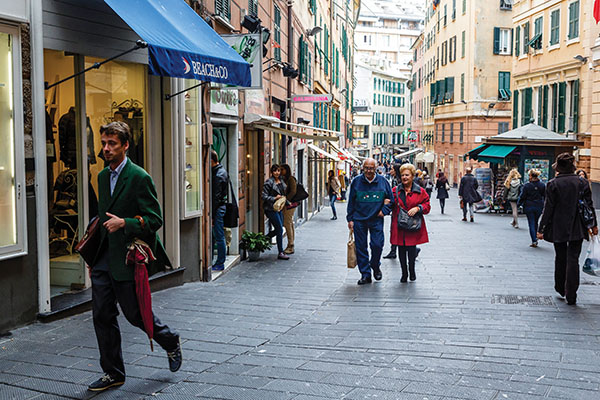
Genoa’s streets are lined with small stores
Day 2: Genoa beckons
The second day dawns clear and bright—this clichéd description will have to suffice because we fail to witness that stirring event. We wake up at 10:30 am and rush to make the breakfast buffet. Later, we check out of the hotel, leaving S’s big suitcase (she’d been travelling for a month) with the staff. We leave with two smallish and more manageable strollers.
Getting to Genoa from Milan is easy enough. You make your way to Milano Centrale train station, pay about 20 euros for a ticket (advance purchase on a non-peak, local train can be had for less than 10 euros), grab a seat on the next train and enjoy the scenery. We are booked at the Grand Hotel Savoia on Via Garibaldi in Genoa, just outside the Piazza Principe railway station. The Savoia does a passable impression of the fictional Grand Budapest Hotel, but we were told that the resemblance is purely coincidental. After a quick check-in, we set out to explore what is one of Europe’s largest medieval cities. Just steps from our hotel, we find ourselves in a maze of narrow crooked streets that eventually lead us to the bustling waterfront. The area is pleasant enough, and the city has spent some money sprucing it up for locals and tourists. There are street performers, Europe’s largest aquarium and an elevated viewing platform designed by one of Genoa’s favourite sons, star architect 77-year-old Renzo Piano. From the platform, we get a wonderful sense of Genoa. The city is surrounded by not-so-gentle hills that seem to tumble down towards the bay.
Heading away from the waterfront, we enter the heart of the old city. Guidebooks tell us that some of the quieter alleys in this part of town are best avoided after sunset, and we aren’t going to challenge convention. There’s plenty to see without wandering too far off the better-trod paths. The quarter is made up of narrow cobblestoned streets lined with small stores selling tourist bric-à-brac interspersed with genuinely interesting establishments, offering high-end products that exude European chic. We make our way past the highlights, namely the Piazza de Ferrari, Palazzo Ducale (the Doge’s Palace) and Cattedrale di San Lorenzo (the San Lorenzo cathedral). The last monument is guarded by two spectacularly carved lions, but they seem timid in appearance. Not quite the look one would expect from a sentinel.
Our next stop is the Caffè degli Specchi on Salita Pollaiuoli, which tops most lists in guidebooks and internet searches of places to grab a drink. It also featured in the movie Scent of a Woman, the original Italian version, Profumo di Donna, not the Hollywood remake starring Al Pacino.
As the day gracefully gives way to twilight, the streets quieten down, but are by no means deserted. We return to our hotel on Via Garibaldi. At its peak, when Genoa was a grand maritime and trading power, the city’s elite built elaborate mansions along this street. Today, several of these magnificent heritage buildings have been taken over by banks or converted into museums. And the entire length of Via Garibaldi is a UNESCO World Heritage site.
We pass a church on the way back to the hotel, and S decides to take a photo of a couple seated on the steps. The two are apparently the town lushes and don’t take kindly to the paparazzo. We beat a hasty retreat, but not until we get an earful of the choicest Italian pleasantries.

Santa Margherita’s waterfront is peaceful and spectacular; the fishing village of Portofino
Day 3: Discovering Cinque Terre
We spend the day exploring the world-famous Cinque Terre, the five coastal villages of Monterosso al Mare, Vernazza, Corniglia, Manarola, and Riomaggiore, perched atop steep hills that guard the azure Mediterranean below. Trains from Genoa pass through each of the villages and we alight at the furthest (from Genoa), Riomaggiore.
The villages lie within the Parco Nazionale delle Cinque Terre (Cinque Terre National Park), which has numerous trails of varying difficulty levels along the water and up in the hills. We plan on following the “relatively easy” Sentiero Azzurro (Blue Trail), which follows the coast linking all five villages only to be thwarted at the outset: The first leg from Riomaggiore to Manarola is closed.
After a quick look up and down Riomaggiore’s main drag, we take the train to Manarola. To reach the village centre from the station, you can either take a bus or walk. We walk, and a-million-and-two steps uphill later, we find ourselves in the heart of Manarola with its church, medieval buildings, narrow twisty streets and piazzas, all charmingly arranged on a hillside overlooking the water.
In its entirety, the Blue Trail is 12 km (7.5 miles) long and we had grand ambitions of completing it in a day. The first (and only) leg we attempted, from Manarola to Corniglia, quickly dissuaded us. It’s a proper hike with lots of ups and downs and, under the bright, warm October sun, we find ourselves longing for London’s cold and damp. However, the views—be they the yellow, orange pink buildings in Manarola behind, the green of the olive groves and vineyards around, or the azure of the Mediterranean below—are worth the effort.

Manarola boasts of churches and medieval buildings on a hillside overlooking the water; a hike to the Castello d’Albertis is worth the effort
Corniglia is right on the water in that it’s perched on a promontory, a high ridge of land or rock that juts out into the sea. It has a small bay filled with boats. There’s a main street lined with shops, restaurants and bars headed away from the bay, and a train station at the other end.
Given the approach of sunset and our exertions, we decided to begin our hour-long train journey back to Genoa. Once there, we stumble upon the Piazza delle Erbe in the old town, just off Via San Lorenzo in front of the Palazzo Ducale. It’s bound on every side by bars, restaurants and gelaterias. We opted for a pizza dinner in the square and chose the delightfully named Quattro Stagioni (Four Seasons) which was topped with olives, peppers, mushrooms and artichoke hearts, all drizzled generously with olive oil. It was predictably delicious. For dessert, we walk into La Cremeria delle Erbe.
Meals in Italy are of such a uniformly high standard that they all tend to blur into one happy food memory. However, every once in a while, you will stumble upon a place of such exceptional quality that it will haunt your food dreams for eternity. While S is a fan of fruity gelato flavours, I am a stracciatella (essentially chocolate chip) guy. So we take the sample of pistachio gelato offered to us with a dose of scepticism. It turns out to be one of the best decisions of the trip. The grainy texture and taste of roasted pistachios is enhanced by the fact that the gelato contains not just the kernel, but also the pistachio skin, which gives it a depth we have never experienced before. La Cremeria delle Erbe’s gelato is now, for us, the standard by which gelato will henceforth be judged.
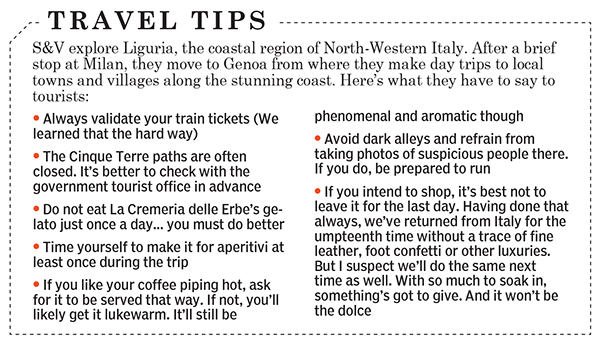
The day starts similarly to the previous in that it involves a short train ride. But instead of catching the train at the station right outside our hotel, we hike across town to Brignole railway station (about 30 minutes away) and arrive just in time to watch our train to Santa Margherita Ligure pull out of the platform.
With time to kill, we step out to find a bite to eat. A long line of non-touristy people draw us to a hole-in-the-wall panini shop. We find ourselves facing two impressively sized menu boards. Our rudimentary knowledge of Italian could not compete with the items listed, and we finally opted for ‘The Special’. And special it was: The simplest and freshest of ingredients—Genoa salami, Provolone cheese, Roma tomatoes and a hint of mischief (pickle)—on a bed of soft white bread. We’d share the name of the place, only we’ve forgotten it. We did look for it on Google Street View, but there’s a half block not covered and this sandwich shop is on it.
We make it back to the station well in time for the next train to Santa Margherita Ligure. Upon meeting the ticket inspector, I greet him with an insouciant “hello” as I brandish our tickets, only to learn that we haven’t endorsed them. He politely informs us that we can either pay a fine or get off at the next stop.
Santa Margherita’s train station is quite picturesque, but is nothing compared to the town itself. A short walk takes us to the Eastern edge of the bay. On land, a small, pebbly beach is rimmed by a road (Via Antonio Gramsci) lined with pastel-coloured buildings. The entire effect—blue water, colourful buildings and abundant greenery—cannot be adequately described with words (or pictures).
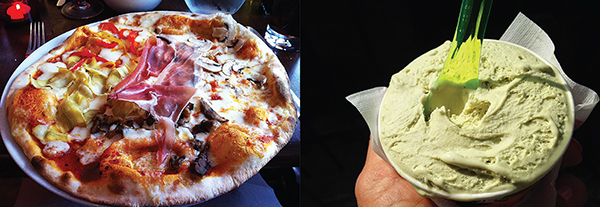
The taste of Itaty: The Quattro Stagioni pizza (top left) and the unforgettable pistachio gelato
As we walk along the waterfront, we realise that we are on the road to Portofino, a mere 5 km away. There’s a footpath for most of the walk, but we occasionally share the narrow road with sports cars driven at manic speed by people we’re convinced could only be Formula 1 drivers in training. There were many interesting sites, but one in particular stands out—a grand residence on the water that would have done a Bond villain proud.
The last stretch has signs strongly suggesting that pedestrians will be better off taking the walkway that leads into the hill above the road. As a result, you approach Portofino from above, along a pine tree-lined path past majestic houses, most of which have tremendous character with vine covered edifices and giant windows looking out onto views that add zeroes to real estate prices.
Portofino is another small bay surrounded by pastel buildings and gently sloping hills (they seem to order them by the dozen on the Riviera). The tiny town centre is filled with high-end boutiques, the sort where €200 keychains seem like bargains.
Upon our return to Genoa, we are subliminally guided back towards Piazza delle Erbe and the gelato at La Cremeria. We run into the drunken couple from two nights earlier. They do not recognise us, but there’s always something wonderful and comforting to see familiar faces in a strange town.
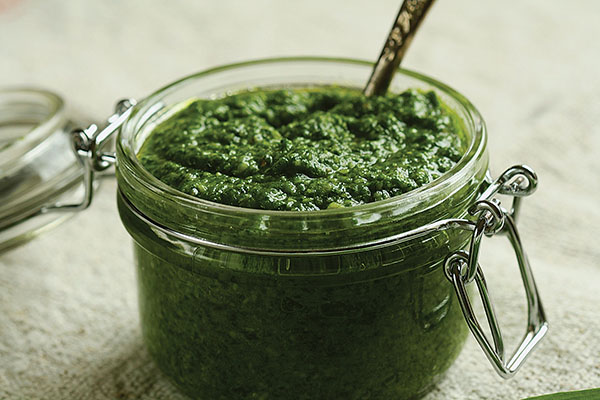
Day 5: Ciao Genoa
With heavy hearts, we prepare to say farewell to Genoa. We leave our bags with the front desk and head out for a last walkabout. And that’s when we stumble upon an intriguing path leading uphill, just a few feet from our hotel. The road zigzags every few metres, and is therefore much longer than it looks. Just when we are about to curse our foolhardiness, we meet a local who suggests we visit the Museo delle Culture del Mondo (Museum of World Cultures) just around the corner. The museum is housed in the Castello d’Albertis (D’Albertis’s Castle), which was once the home of Italian navigator and philanthropist Enrico Alberto d’Albertis. The castle’s well-tended grounds offer great views of the city and bay below.
We finally turn back towards the town-centre via a circuitous route that offers plenty of great views and ‘selfie’ spots. We wind our way to Via Roma, the main artery of the toniest shopping district in town. We usually enjoy browsing in these boutiques, but today, after a cursory look, we head on to more important things.
Each Italian province is renowned for its own specialties, and Liguria (of which Genoa is the capital) is no exception. We have tried the fresh made pesto, which was revelatory when compared to our local supermarket’s green-mush-in-a-jar, and today we are on a mission to sample the pandolce (aka ‘how the Ligurians do fruit bread’). We got our fix at Panarello, a cafe and patisserie on Via Galata. The combination of aromatic cappuccino and spongy pandolce peppered with sultana raisins and fragrant orange peels makes our imminent departure a little less melancholic.
The honour of hosting our farewell Genoa cocktail and aperitivi falls to Il Barbarossa, nestled under the two towers of city gates, in the centre of Genoa, on Piano San Andrea. There’s a life-size statue of Elvis at the entrance, but we were too immersed in our maudlin thoughts of leaving Genoa to question the King’s presence in Italy. We are suitably impressed by the list of 120 cocktails and over 90 varieties of rum and whiskey, but soon realise there’s only one drink that will do justice to the occasion and the scrumptious, bite-sized, salami-wrapped breads we’ve ordered: The Aperol Spritz. The popular Italian cocktail, which is two parts Aperol (a liqueur) and three parts Prosecco (sparkling Italian wine), goes down smoothly as we raise a toast to Genoa, an enchanting city by the sea that bewitches all who visit it.
(This story appears in the Mar-Apr 2015 issue of ForbesLife India. To visit our Archives, click here.)
